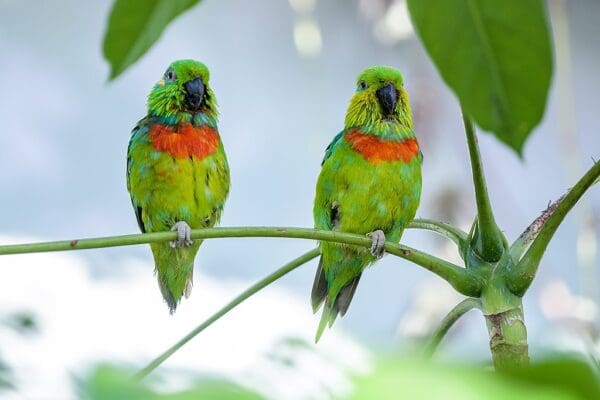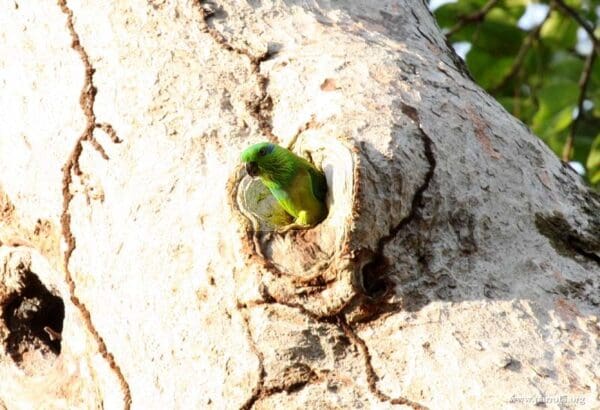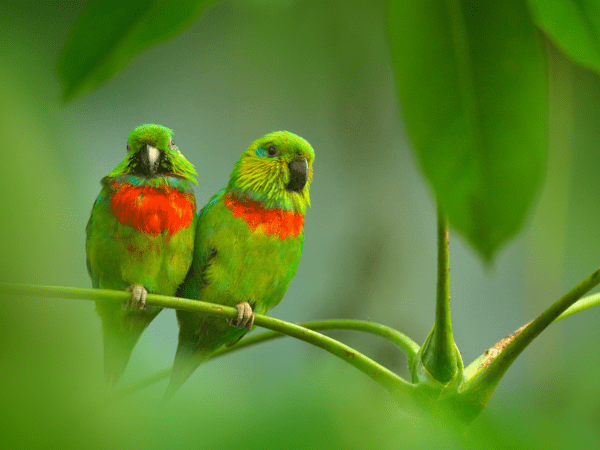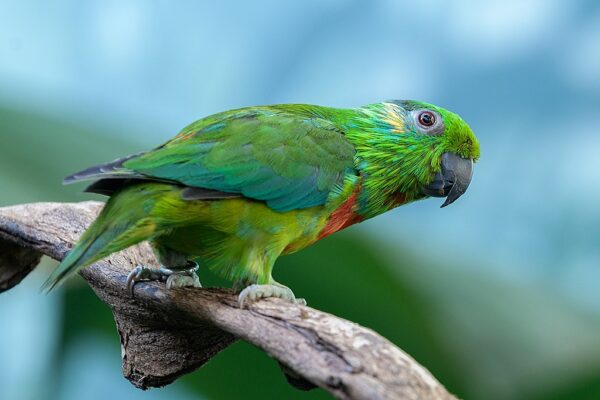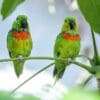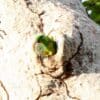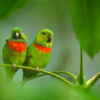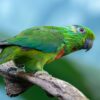Salvadori’s Fig Parrot
Also known as:
Whiskered Fig Parrot
Also known as:
Whiskered Fig Parrot

Psittaculirostris

salvadorii
Size:
19 cm (7.4 in)
Weight:
118 g (4.1 oz)
Subspecies including nominate:
one
Colour Adult:
Male-golden yellow longish feathers of cheeks and ear coverts; blue stripe behind eye; red/orange wide band across chest with pale blue patch on each side of breast which varies from bird to bird; orange/red edging on inner wing coverts; wide underwing stripes cream/yellow. Beak grey/black. Eye red. Female-wide pale blue band across breast with orange/rust markings on each side of breast which varies from bird to bird; yellow/green longish thin feathers on cheeks and ear coverts.
Colour Juvenile:
As in adult female but in general duller in colour; pale blue chest band faint or invisible. Eye red/brown.
Call:
Calls while flying or perching include a stronger call that is a single short note, broken two or three times in a staccato trilling song. Weaker call is high-pitched and squeaky, but not shrill or staccato.
More Information:
Content Sources:
CITES
BirdLife International
Cornell Lab of Ornithology/Birds of the World
Parrots: A Guide to Parrots of the World, Juniper and Parr, 1998
Parrots of the World, Forshaw, 2006. 2010 edition
Parrots in Aviculture, Low, 1992.
Lexicon of Parrots, Thomas Arndt.
Parrots: Their Care and Breeding, Low, 1986.
Captive Status:
Rare
Longevity:
—
Housing:
Walk-in enclosure, minimum length 2.1 m (7 ft) or indoor aviary minimum length 1.8 m (6 ft).
Diet:
Soaked dry figs (soak in filtered water for a few hours), two or more per bird daily; one drop of Konakion (Roche) or other vitamin K additive; fruits such as: apple, pear, orange, kiwi, guava, papaya, cactus fruits, forming at least 50 percent of diet; soaked sultanas; berries such as: elder, mountain ash, blueberries (unsprayed), pyracantha; spray millet; small seed mix such as: canary, oats, safflower and a little hemp; limited sunflower seed; cooked beans and pulses; rearing food consisting of: hard boiled egg, wholegrain bread and carrot, all ground to crumbly consistency; breeding diet: large quantities of clean mealworms during first 3 weeks of life, commercial insectivorous food. Withhold seed for first 3 weeks of chicks’ lives.
Enrichment:
Vigorous chewers so provide heat-sterilized pine cones, unsprayed flowering, fir, pine, elder or willow branches; wooden block or vegetable tanned leather toys; swings, ladders and ropes (non-sisal). Provide overhead misters or shallow water bowls for bathing.
Nest Box Size:
L-shaped nest box with 5″ x 10″ (12 cm x 25 cm) base, 5″ (12 cm) high.
Clutch Size:
2
Fledging Age:
8 weeks
Hatch Weight:
—
Peak Weight:
—
Weaning Weight:
—
World Population:
20,000-50,000 mature individuals, decreasing.
IUCN Red List Status:
Least Concern
CITES Listing:
Appendix II
Threat Summary:
A BirdLife “restricted-range” species. Large numbers have been trapped for the wild bird trade. Extensive loss of habitat to timber and agriculture have also been threats and together with trapping are judged to be causing a substantial decline in numbers. This species is considered to have a high dependency on forest habitat, and tree cover is estimated to have declined by 0.9% within its mapped range over the past three generations. It is therefore tentatively suspected that this may have led to a 1-19% decline in the species’ population over the same period, with a best estimate of less than 5%.
Range:
NW New Guinea, from Humboldt Bay and Cyclops Mountains to the eastern shores of Geelvink Bay, West Papua.
Habitat:
Found up to 700 m (2296 ft). Seen in forest, along forest edge, in partly cleared areas and near towns and villages.
Wild Diet:
Feeds on Ficus figs, fruit, nectar and flowers.
Ecology and Behaviour:
Gregarious; mixing with other species of birds. Birds hang upside down to feed, and make brief sorties above the forest canopy. Most frequently seen in pairs or small groups; they also nest in colonies.
Clutch and Egg Size:
2
Breeding Season:
Breeding time unknown. Seen prospecting cavity in tree.
Related Links:
—
